 W
WDendropsophus microcephalus is a species of frog in the family Hylidae. It is found in southeastern Mexico, Central America, and northern South America in Colombia, Venezuela, Trinidad and Tobago, the Guianas, and northern Brazil. This widespread species might actually be a species complex. Its common names include yellow treefrog, small-headed treefrog, and yellow cricket treefrog.
 W
WDendropsophus robertmertensi is a species of frog in the family Hylidae. It is found in the Pacific lowlands of El Salvador, Guatemala, and southeastern Mexico. A separate population exists in the Cintalapa Valley in Chiapas.
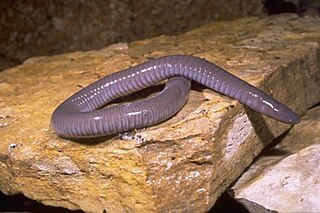 W
WThe Mexican burrowing caecilian is a species of limbless amphibian in the family Dermophiidae. It is found in Mexico and Central America, where it burrows under leaf litter and plant debris.
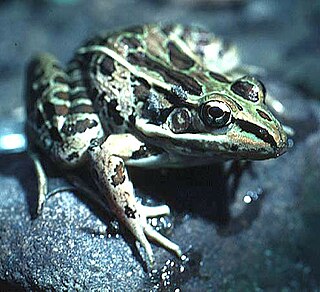 W
WForrer's grass frog or Forrer's leopard frog, Lithobates forreri, is a species of frog in the family Ranidae found in Mexico and Central America through Guatemala, El Salvador, Honduras, and Nicaragua to Costa Rica. It is a widespread and common frog found in lowland and seasonal tropical forests. It can also adapt to man-made habitats such as flooded agricultural lands and other water content systems. Reproduction requires permanent pools and lagoons.
 W
WThe Gulf Coast toad is a species of toad native to eastern and southeastern Mexico and Central America as far south as Costa Rica.
 W
WHyalinobatrachium fleischmanni, the Fleischmann's glass frog or northern glass frog, is a species of frog in the family Centrolenidae. It is found in the tropical Americas from southern Mexico to Ecuador. Specifically, these frogs occur in Mexico, Belize, Costa Rica, El Salvador, Guatemala, Honduras, Nicaragua, and Panama, Colombia, and Ecuador. Notice that this and related species have often been confused with each other, and the exact distribution depends on the source.
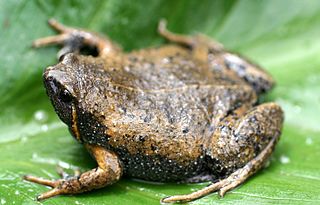 W
WHypopachus barberi is a species of frog in the family Microhylidae. It is found in El Salvador, Guatemala, Honduras, and Mexico. This species is found in humid pine-oak forests at the elevations of 1,470–2,200 m (4,820–7,220 ft) asl. It is threatened by habitat loss due to logging.
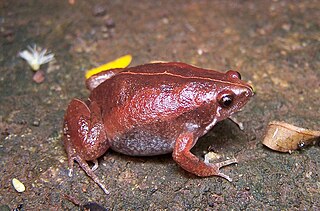 W
WHypopachus ustus, the two-spaded narrow-mouthed toad, is a species of frog in the family Microhylidae found in El Salvador, Guatemala, and Mexico. Its natural habitats are tropical dry and moist lowland forests. Breeding takes place in both temporary and permanent ponds. As this species is widespread and can live modified habitats, it is not considered threatened.
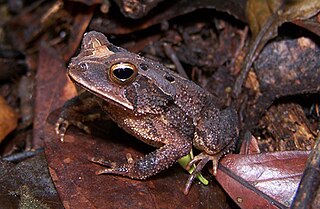 W
WIncilius canaliferus, also known as the dwarf toad, is a species of toad in the family Bufonidae. It is found along the Pacific slopes of western El Salvador, Guatemala, and southern Mexico. Its natural habitats are semi-deciduous forests near rivers and moderate-sized streams. Breeding takes place in ponds and streams. It also occurs in disturbed habitats, for example coffee plantations. Habitat loss and possibly water pollution are threats to this toad.
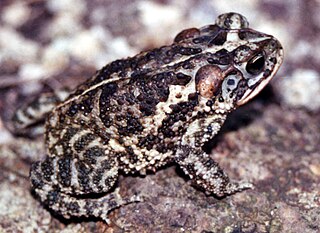 W
WIncilius coccifer is a species of toad in the family Bufonidae. It is found in southern Mexico and southeastward in the Central America through Guatemala, El Salvador, Honduras, and Nicaragua to northwestern Costa Rica. Several species that were formerly included in this species have been named as distinct species: Incilius porteri, Incilius ibarrai, Incilius pisinnus, and Incilius signifer. Its natural habitats are lowland dry and moist forests, and it occurs also in disturbed areas such as pastures, roadside ditches, gardens, and vacant lots in urban areas. It is an abundant and widespread species that is not facing significant threats.
 W
WIncilius luetkenii is a species of toad in the family Bufonidae. It is found in the Mesoamerica along the Pacific versant from central Costa Rica to extreme southern Chiapas, Mexico, as well as dry interior valleys of Guatemala and Honduras and San Juan River drainage in Costa Rica on the Atlantic versant. It occurs in open areas, including disturbed pasturelands in lowland dry forest, and to a lesser extent, in lowland moist and premontane moist forests. It breeds in temporary pools. It is a common species that is not facing major threats.
 W
WLeptodactylus fragilis, known under many common names such as the Mexican white-lipped frog, American white-lipped frog or simply white-lipped frog, is a species of leptodactylid frog. Its distribution ranges from the Lower Rio Grande Valley of Texas in the United States south through Mexico and Central America to Colombia and Venezuela. It is often—wrongly—referred to as Leptodactylus labialis (Cope, 1878), which is a junior synonym of Leptodactylus mystacinus.
 W
WLeptodactylus melanonotus is a species of frog in the family Leptodactylidae. It is found in Central America. Its natural habitats are subtropical or tropical dry forests, subtropical or tropical moist lowland forests, subtropical or tropical mangrove forests, subtropical or tropical moist montane forests, dry savanna, moist savanna, subtropical or tropical seasonally wet or flooded lowland grassland, intermittent freshwater lakes, freshwater marshes, intermittent freshwater marshes, pastureland, plantations, rural gardens, urban areas, heavily degraded former forest, water storage areas, ponds, and canals and ditches.
 W
WThe Mexican narrow-mouthed toad is a species of sheep frog native to the Pacific and Caribbean lowlands from southern Texas to Costa Rica. Sheep frogs make a distinctive call that resembles a sheep's bleat during and after rainfall in warm months.
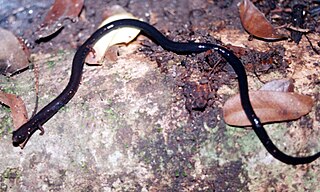 W
WOedipina taylori, commonly known as Taylor's worm salamander, is a species of salamander in the family Plethodontidae. It is found on the Pacific versant in south-eastern Guatemala, to central to north-eastern El Salvador and adjacent southern Honduras. Honduran populations might represent another species.
 W
WPlectrohyla guatemalensis, also known as the Guatemala spikethumb frog, is a species of frog in the family Hylidae. It occurs in the highlands of the Sierra Madre from southeastern Chiapas, Mexico, and eastward through the central and southwestern highlands of Guatemala to northwestern El Salvador as well as the Sierra de Nombre de Dios in north-central Honduras. It might be a composite of more than one species.
 W
WPlectrohyla sagorum is a species of frog in the family Hylidae. It is found in the Sierra Madre de Chiapas from Chiapas (Mexico) to southwestern Guatemala, with a single record from northwestern El Salvador. Its natural habitats are cloud forests at elevations of 1,000–2,050 m (3,280–6,730 ft) above sea level. Breeding takes place in streams. It is very rare in Mexico and El Salvador but abundant at two Guatemalan sites. It is threatened by habitat loss. Chytridiomycosis might also be a threat.
 W
WPtychohyla salvadorensis is a species of frog in the family Hylidae found in El Salvador, Guatemala, and Honduras. Its natural habitats are subtropical or tropical moist montane forests, rivers, pastureland, and heavily degraded former forests. It is threatened by habitat loss.
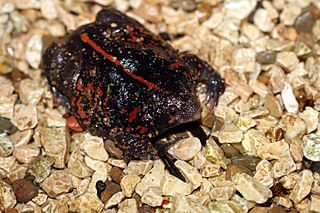 W
WThe Mexican burrowing toad is the only species in the genus Rhinophrynus and the family Rhinophrynidae of order Anura. Their distribution stretches from south Texas through Mexico, Belize, Guatemala, Honduras, and El Salvador to Nicaragua and Costa Rica. R. dorsalis mostly commonly inhabits the subtropical and tropical dry forests within its range characterized by wet and dry seasons, but may also be found during periods of heavy rain in pastures, cultivated field, roadside ditches or other open areas. The family was once more widespread, including species ranging as far north as Canada, but these died out in the Oligocene.
 W
WThe túngara frog is a species of frog in the family Leptodactylidae.